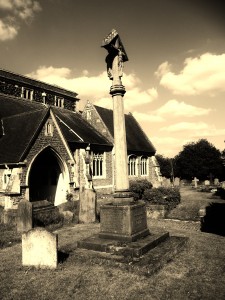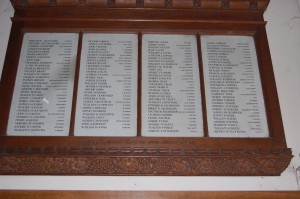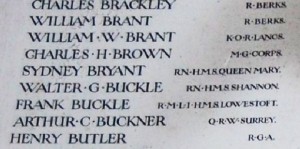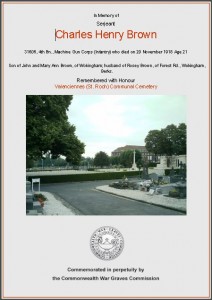 Charles Henry Brown died 20th November 1918
Charles Henry Brown died 20th November 1918
Charles was born in Binfield, Berkshire, the only son of John and Mary Ann Brown. He did however, have four half brothers, Henry, George, Joseph and Frederick Sargeant from Mary’s earlier marriage to the late Henry Sargeant (died 1897). His nearest half brother Frederick, who was still living with the family in 1901 was later to be killed at the Somme in 1916 and is remembered on the same memorial (his story). Charles was though, John Brown’s only son.
In 1914, at the young age of 17, Charles married Rose Piercy who was six years his senior. At the time of writing we are not aware of any children from this marriage and there are none mentioned in his biography on the CWGC war records. Charles was obviously a bright, hard working man as he had made sergeant before his death at the age of only 21 years. 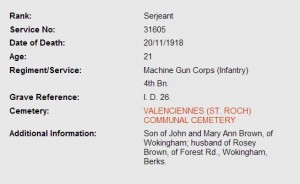 He had joined the Machine Gun Corps and died on the 20th November 1918, nine days after the war had effectively ended on the 11th. Although it is likely he ill from disease or wounded, he did not make it home and is buried at Valenciennes (St Roch) in France. Here is some general information which describes the types of burials at this cemetery:
He had joined the Machine Gun Corps and died on the 20th November 1918, nine days after the war had effectively ended on the 11th. Although it is likely he ill from disease or wounded, he did not make it home and is buried at Valenciennes (St Roch) in France. Here is some general information which describes the types of burials at this cemetery:
Historical Information
Valenciennes remained in German hands from the early days of the First World War until 1-2 November 1918, when it was entered and cleared by the Canadian Corps; 5,000 civilians were found in the town. In November and December 1918, the 2nd, 57th, 4th Canadian and 32nd Casualty Clearing Stations were posted at Valenciennes and the last of them did not leave until October 1919.
The Communal Cemetery of St. Roch was used by the Germans in August and September 1914 and an extension was then made on the south-east side. The Commonwealth plots were made adjoining the German: I and II contain the graves of October 1918 to December 1919; III, IV, V and part of VI contain the graves of 348 soldiers buried originally in the German Extension and 226 whose bodies were brought from other cemeteries or from the battlefields. The German Extension has since been removed and the Commonwealth plots are within the enlarged Communal Cemetery.
The following were among the burial grounds from which graves were moved to this cemetery:-
‘Valenciennes remained in German hands from the early days of the First World War until 1-2 November 1918, when it was entered and cleared by the Canadian Corps; 5,000 civilians were found in the town. In November and December 1918, the 2nd, 57th, 4th Canadian and 32nd Casualty Clearing Stations were posted at Valenciennes and the last of them did not leave until October 1919.
The Communal Cemetery of St. Roch was used by the Germans in August and September 1914 and an extension was then made on the south-east side. The Commonwealth plots were made adjoining the German: I and II contain the graves of October 1918 to December 1919; III, IV, V and part of VI contain the graves of 348 soldiers buried originally in the German Extension and 226 whose bodies were brought from other cemeteries or from the battlefields. The German Extension has since been removed and the Commonwealth plots are within the enlarged Communal Cemetery.
The following were among the burial grounds from which graves were moved to this cemetery:-
ARTRES BRITISH CEMETERY, on the road from Artres to Preseau, contained the graves of 32 soldiers of the 61st (South Midland) Division who fell on the 1st November 1918.
MONT-DES-BRUYERES BRITISH CEMETERY, ST. AMAND-LES-EAUX, where 17 soldiers from the United Kingdom, who fell in October and November 1918, were buried.
The cemetery now contains 885 Commonwealth burials and commemorations of the First World War. 37 of the burials are unidentified. Special memorials commemorate 19 casualties who died as prisoners of war, of whom nine are buried here (Plot IV, Row A.) and ten at Le Quesnoy Communal Cemetery Extension, none of whom could be individually identified; all are therefore commemorated at both sites. Other special memorials record the names of seven soldiers buried in other cemeteries whose graves could not be found.’

